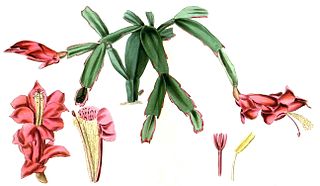
Schlumbergera truncata, the false Christmas cactus, is a species of plant in the family Cactaceae. It is endemic to a small area of the coastal mountains of south-eastern Brazil where its natural habitats are subtropical or tropical moist forests. It is the parent or one of the parents of the houseplants called Christmas cactus or Thanksgiving cactus, among other names.
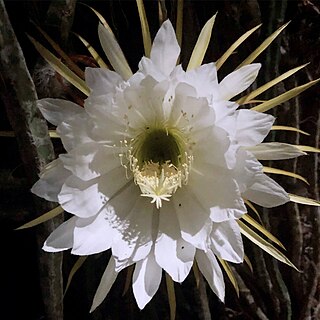
Night-blooming cereus is the common name referring to a large number of flowering ceroid cacti that bloom at night. The flowers are short lived, and some of these species, such as Selenicereus grandiflorus, bloom only once a year, for a single night. Other names for one or more cacti with this habit are princess of the night, Honolulu queen, Christ in the manger, dama de noche and queen of the night.

Schlumbergera is a small genus of cacti with six to nine species found in the coastal mountains of south-eastern Brazil. These plants grow on trees or rocks in habitats that are generally shady with high humidity, and can be quite different in appearance from their desert-dwelling cousins. Most species of Schlumbergera have stems which resemble leaf-like pads joined one to the other and flowers which appear from areoles at the joints and tips of the stems. Two species have cylindrical stems more similar to other cacti. Recent phylogenetic studies using DNA have led to three species of the related genus Hatiora being transferred into Schlumbergera, though this change is not universally accepted.

Epiphyllum is a genus of epiphytic plants in the cactus family (Cactaceae), native to Central America and South America. Common names for these species include climbing cacti, orchid cacti and leaf cacti, though the latter also refers to the genus Pereskia.

Disocactus is a genus of epiphytic cacti in the tribe Hylocereeae found in Central America, the Caribbean and northern South America. It should not be confused with Discocactus, which is a different genus.
Rat tail cactus is the common name for several members of the cactus family:

Disocactus ackermannii is an epiphytic cactus from tropical forests in the states of Veracruz and Oaxaca, Mexico. In cultivation, it has been confused with Disocactus × jenkinsonii, a hybrid between D. phyllanthoides and D. speciosus.

Disocactus crenatus, the crenate orchid cactus, is a species of cactus and one of the most important parents in creating the epiphyllum hybrids commonly cultivated throughout the world. It is cultivated for its large white flowers.
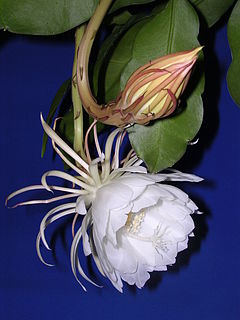
Epiphyllum oxypetalum, the Dutchman's pipe cactus, princess of the night or queen of the night, is a species of cactus. It rarely blooms and only at night, and its flowers wilt before dawn. Though it is sometimes referred to as a night-blooming cereus, it is not closely related to any of the species in the tribe Cereeae, such as Selenicereus, that are more commonly known as night-blooming cereus. All Cereus species bloom at night and are terrestrial plants; Epiphyllum species are usually epiphytic.

Disocactus phyllanthoides, the nopalxochitl or German empress, is a species of flowering plant in the cactus family Cactaceae. It is commonly grown as an ornamental houseplant. It is one of the three major species involved in creating the widely grown epiphyllum hybrids or "epis". The others are Disocactus speciosus and Disocactus crenatus.
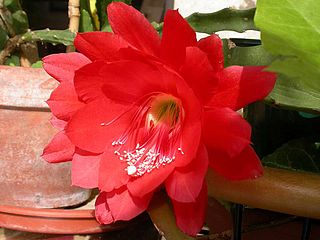
Disocactus × jenkinsonii is a hybrid between Disocactus phyllanthoides and Disocactus speciosus. It is perhaps the most commonly grown orchid cactus and seems to survive and flower under most conditions. It has a very complex taxonomic history and has been mistaken for Disocactus ackermannii for a long time.

Selenicereus anthonyanus is a cactus species native to southern Mexico. It is grown as an ornamental because of its nocturnal flowers and unusual, leaf-like stems. Common names include fishbone cactus, rick rack cactus, zig-zag cactus and St. Anthony's rik-rak, and is sometimes referred to as an orchid cactus.

Disocactus anguliger, commonly known as the fishbone cactus or zig zag cactus, is a cactus species native to Mexico. The species is commonly grown as an ornamental for its fragrant flowers in the fall.

Schlumbergera opuntioides is a species of plant in the family Cactaceae. It is endemic to the coastal mountains of south-eastern Brazil where its natural habitats are humid forests and rocky areas. It is threatened by habitat loss. It is in the same genus as the popular house plant known as Christmas Cactus or Thanksgiving Cactus.
Moon cactus or mooncactus may refer to:

Schlumbergera gaertneri, formerly Hatiora gaertneri, is a species of epiphytic cactus which belongs to the tribe Rhipsalideae within the subfamily Cactoideae of the Cactaceae. Together with the hybrid with S. rosea, Schlumbergera × graeseri, it is known as Easter cactus or Whitsun cactus and is a widely cultivated ornamental plant. It has received the Royal Horticultural Society's Award of Garden Merit.
The Hylocereeae are a tribe of cacti. Most are found in the tropical forests of Central and northern South America, and are climbers or epiphytes, unlike most cacti. The tribe includes between six and eight genera in different circumscriptions. The plants known as "epiphyllum hybrids" or "epiphyllums", widely grown for their flowers, are hybrids of species within this tribe, particularly Disocactus, Pseudorhipsalis and Selenicereus, less often Epiphyllum, in spite of the common name.

Epiphyllum hybrids, epiphyllums, epicacti, or just epis, also known as orchid cacti, which are widely grown for their flowers, are artificial hybrids of species within the group of cacti placed in the tribe Hylocereeae. In spite of the common name, epiphyllum hybrids mainly involve Disocactus species instead of Epiphyllum species, though Selenicereus grandiflorus and some unconfirmed Epiphyllum species were reportedly used for hybridization. Other sources include Pseudorhipsalis in the parentage of the group.
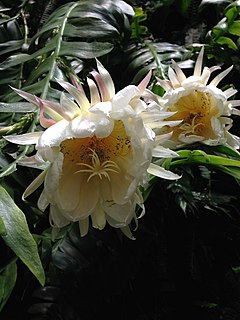
Epiphyllum chrysocardium is an epiphytic cactus native to Mexico. It used to be the only species in the genus Chiapasophyllum or one of the species in the genus Selenicereus, but molecular phylogenetic studies show that it belongs to Epiphyllum.
















